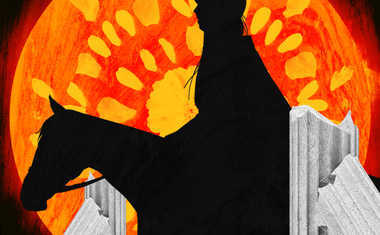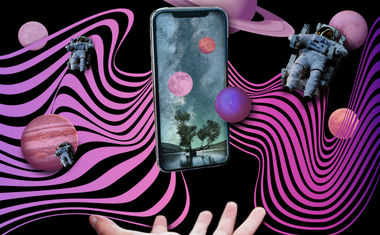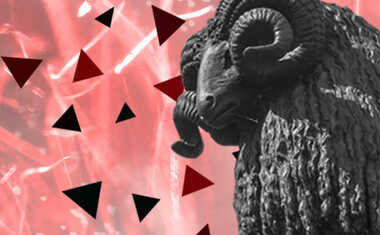
Tarot Bagatto Cards
The Iconology from 15/16th Century
In the 15th century, the modern Magician card was known as "Bagatto". The five surviving images of the Bagatto from the 15/16th century are shown in Figure 1. All show a man standing or sitting at a table. They wear a variety of hats, but it is interesting to note one Bagatto wearing a foolscap. This shows the connection between the Fool and Bagatto that was noted in the last chapter. A similar image showing the mixture of Fool and Bagatto imagery can be seen at (1).
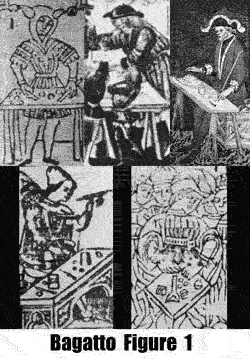 Two of the early Tarot images show the audience that is being entertained. Although it is difficult to see in some of the cards, three of the figures are wearing the long, pointed shoes that were high fashion in the 15th century. The table holds objects that range from balls and cups to dice and knives. In three of the images, the Bagatto holds a wand.
Two of the early Tarot images show the audience that is being entertained. Although it is difficult to see in some of the cards, three of the figures are wearing the long, pointed shoes that were high fashion in the 15th century. The table holds objects that range from balls and cups to dice and knives. In three of the images, the Bagatto holds a wand.
Because of the table and the variety of objects, the figures in Fig. 1 resemble images of the artisan or alchemist, such as that found in the 'tarocchi of Mantegna' (2).
Similar images of the artisan also appear in woodblock images of the planets and their children under Mercury (e.g., Hind 1935, Fig 105 ~1470). One such image (3). shows a goldsmith, a doctor performing a dissection and a couple at table with carafe, plates, glasses, balls. An image of the artisan as goldsmith (alchemist?) also appears in stained glass in the Milan Cathedral (Fig. 2, ~1480) where the objects on the table include bowls, tools, and a ring. Contemporary images of the artisan (4) , (5), often bear a distinct resemblance to the early Bagatto card.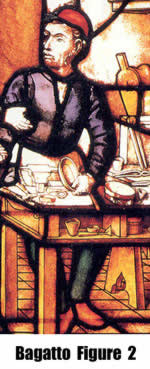
Yet another image of the artisan appears in an astrological woodcut of 1515 (Fig. 3). Figure 3 is primarily of interest because the artist, Erhard Schoen, is known to have produced woodcuts for German playing cards. Therefore, it is probably not surprising to find that entire woodcut appears to contain several images that resemble early Tarot images. As a result, we will return to this same woodcut a number of times in future chapters as images that may be related to the emperor, pope, lovers, wheel, hangedman and death all appear in this single nativity calendar. The implied association of the Tarot image with divination may seem tenuous, yet other images of the magician/astrologer/diviner (6) do bear some resemblance to the early Tarot image.
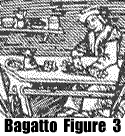 And although it may lead to greater confusion than enlightenment, we must also report an image of Jupiter from an early manuscript (Fig. 4). The image shows Jupiter as emperor standing before a table with cups, discs, knife and holding a scepter!
And although it may lead to greater confusion than enlightenment, we must also report an image of Jupiter from an early manuscript (Fig. 4). The image shows Jupiter as emperor standing before a table with cups, discs, knife and holding a scepter!
These images of the artisan, suggesting associations with alchemy and astrology, show sufficient resemblance to the early Tarot cards that one can argue to an intended association. The status of the artisan as a distinct "estate of man" also seems to fit the other estates represented in later cards. However, it is difficult to argue that the images in Fig. 1 represent an artisan in his workshop, rather than a street entertainer.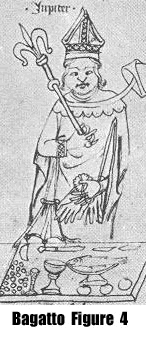
The contemporary images of the street entertainer seem a closer fit to Figure 1. For example an image of Bosch, known as the Magician (7), shows a man behind a table playing tricks for the attentive audience and seems closer to the early Tarot images. Likewise, the 1523 image of the "Charlatan" by Van Leyden (Fig. 5) seems closer to the mark with the array of cups, balls, and rods on the table. Another example, (8) shows the mountebank peddling wares. Other contemporary images shows the peddler as dentist (9) and there is even an image that implies that Bagatto could be taken for a doctor (10) It appears that the available 15/16th century imagery could justify the idea of the Bagatto as artisan. But the images of the magician or charlatan seem closer to the early cards in Fig. 1. The Bagatto was likely thought about as a sort of street magician that could play a trick or fix a toothache with equal ease.
Religious tradition
I am not aware of any Christian imagery that represents the Bagatto. This is probably due to the fact the theology of the times suspected the "juggler" as being a magician. In a 12th century tract designed to guide the local pastor in directing his parishioners, the question is asked whether a "jongleur" will be saved. The answer is no, for they are servants of Satan (Gurevich 1988). There is also an Inquisition record of a jester who was accused of distilling and selling magical cures (Ginsberg 1986).
Triumphal tradition
I am also unaware of any imagery in the Triumphal tradition that corresponds to the early cards in Fig. 1. One might argue that the street entertainer would have been part of the spectacle envisioned by Moakley (1966). One might argue that the Bagatto might be viewed as Fool's guide who, like Petrarch's Virgil, explained the passing spectacle to the Fool. However, this interpretation seems forced and is not evidenced by anything in the early cards, Petrarch's poem, or the artistic tradition associated with the Triumphs.
Dance of death tradition
Insofar as the early cards can be identified with the artisan, then this card can be associated with the Dance of Death. The poems and illustrations include the artisan as one of the lowest, estates of man, and is one of the first characters danced off to their death. But if the early cards are taken to represent a street entertainer and magician, then this figure does not appear in the poems and I am unaware of any imagery that resembles the Bagattos of Fig. 1.
Apocalyptic tradition
The character of the artisan or street entertainer does not enter into the book of Revelations and I am not aware of any imagery in this tradition that can be associated with the early cards.
Iconological Analysis
The street entertainer was a familiar figure in 14/15th century Northern Italian cities. The same individual might juggle balls, sell medicines, extract teeth, tell stories, sing, dance, and do some sleight of hand (Burke 1978). Mixed in with the entertainers were wandering holy men who preached. This same collection of street entertainers could still be found in European cities in the late 19th and 20th centuries (Berouet and Laurendon 1995).
Although the entertainers were merely tricksters, their feats were often so impressive that they were thought of as magicians (Burke 1978, p. 94). Thus, we should not be too surprised to discover that the Bagatto image of the 15th century street entertainer eventually become known as the magician.
As we discussed in the previous chapter on the Fool, tales of the Fool/Trickster seem to fulfill Jung's concept of an archetypic image (Eliot et al 1990). They are enigmatic and cross-cultural. The specific examples of this archetypic myth in which the Trickster is the artificial Fool (i.e., aware of the deceit) seem to fit the images of the charlatan or joglar of the early Tarot cards (Fig. 1). Among Native Americans, such tales can be found in the Great Plains (Goble 1996) and the Pacific Northwest (McDermott 1993). Similar legends exist in West Africa (Bennett 1994) and in the West Indies (Hamilton 1997). It is particularly difficult to avoid the archetypic nature of these legends when one discovers similar stories in Hawaii (Thompson 1994) and Amazonia (Basso 1987).
Interpretation
It is not difficult to imagine the 15th century card-player seeing the street magician in the early card images. The itinerant mountebank was a familiar urban figure. The pentitentials (books written for parish priests advice them on how to handle sins that they might hear in the confessional) warn against the "carriages" or juggler as a purveyor of pagan magic (McNeill and Gamer 1938). This homeless figure was surely assigned to a low estate and yet had a degree of skill and wisdom (today we would call it "street-smarts") that the card-player might have related to.
The images in Fig. 1 might have been seen by some as an artisan, particularly by those card-players who were artisans themselves. The artisan as alchemist is also a possible interpretation but unlikely to be the first association made by the ordinary card-player.
In addition to being the lowest estates, the Fool and Bagatto also relate to the archetypic trickster/magician. This character would have been known to the card-player through folk tales and public morality plays. So the Bagatto probably also elicited the idea of the wise fool, an entertaining juggler and sleight-of-hand artist, but with a deeper practical wisdom.
But perhaps the greatest insight into the strange juxtaposition of Fool and Trickster may be found in the popular religious tracts. The Elucidarium was written by Honorius of Autun at the turn of the 11th/12th century. The intent was to translate the complexities of orthodox theology into terms that the layman could understand (Gurevich 1988). This "Catechism" was used by clergy for centuries and was a major source for instruction and explanation. In this popular and well-known work, we find the Fool and Trickster as another duality of basic good and evil: "Do jongleurs have any hope? None, for they are servants of Satan... As for madmen, they are like children and shall be saved" (Gurevich 1988, pp154f). So it is feasible that the Fool-Bagatto pairing is a deliberate juxtaposition of good/evil or innocence/deceit that might have been familiar to the card-player.
The Fool/Bagatto pairing also has interesting connotations if one regards the Tarot as representing the Fool's Journey. It appears that the first person that the Fool encounters on his journey is a street-wise trickster/diviner/magician.
